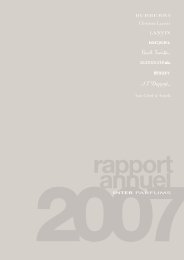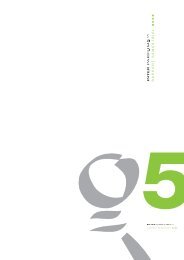2006 - Interparfums
2006 - Interparfums
2006 - Interparfums
Create successful ePaper yourself
Turn your PDF publications into a flip-book with our unique Google optimized e-Paper software.
1.3<br />
Basis of consolidation<br />
Inter Parfums Trademark and Inter Parfums Grand Public are<br />
wholly controlled by Inter Parfums, and as such have been<br />
fully consolidated since July 1994 as has Nickel since April<br />
2005. All consolidated companies close their accounts on<br />
December 31. No company has been excluded from the<br />
consolidation scope.<br />
1.4<br />
Harmonization of accounting methods<br />
The financial statements of subsidiaries according to the<br />
same fiscal year as the parent company.<br />
1.5<br />
Translation method<br />
The companies operating currency and currency for the<br />
presentation of financial statements is the euro.<br />
Transactions in foreign currencies are translated at the<br />
exchange rate in effect on the date of the transaction. Foreign<br />
currency denominated payables and receivables are translated<br />
at the exchange rate in effect as of December 31, <strong>2006</strong>.<br />
Translation losses and gains arising from the conversion of<br />
accounts denominated in foreign currencies on December 31,<br />
<strong>2006</strong> are recorded in the income statement. Hedged<br />
transactions are translated at the negotiated exchange rate.<br />
1.6 Use of estimates<br />
The preparation of consolidated financial statements requires<br />
the use of estimates and assumptions. Although these<br />
estimates are based on management’s best knowledge of<br />
current events and actions, actual results may ultimately differ<br />
from these estimates.<br />
1.7 Revenue recognition<br />
Revenue is recognized upon transfer of title. Amounth<br />
invoiced at year-end when actual transfer of title occurs in<br />
the following year are not recognized under revenue of<br />
the year in progress.<br />
1.8<br />
Trademarks and other intangible assets<br />
Trademarks and other intangible fixed assets, including<br />
trademarks under licensing contracts and acquired<br />
trademarks are recorded at cost.<br />
Trademarks that have widely recognized international<br />
notoriety and are legally protected are classified as indefinite<br />
life intangible assets and are not amortized.<br />
Finite life intangible assets such as upfront license fees are<br />
amortized on a straight-line basis over the duration of the<br />
license. Rights on glass molds are classified as finite life<br />
intangible assets.<br />
Trademarks and upfront license fees are remeasured at least<br />
once a year or whenever there is an indication of impairment<br />
on the basis of value in use defined as the present value of<br />
estimated future cash flows expected to arise from the<br />
continuing use of these assets. Data used originates from the<br />
annual and multiyear budgets drawn up by Management.<br />
The discount rate before tax applied for remeasurement is<br />
the10 year annual percentage rate (APR). A provision for<br />
impairment is recorded under income if this value declines.<br />
Under IAS 38.27b revised in 2004, costs generated on<br />
acquisition analyzed as directly attributable costs are included<br />
<strong>2006</strong> annual report inter parfums<br />
notes to the consolidated financial statements<br />
in the cost of the acquired assets.<br />
Other intangible assets are amortized over their useful lives<br />
and subject to impairment testing when an indication<br />
of impairment exists. No impairment was recorded<br />
at December 31, <strong>2006</strong>.<br />
1.9<br />
Goodwill<br />
Goodwill is defined as the difference between the purchase<br />
price of shares of consolidated companies and the Group's<br />
share in their net assets at the date of acquisition. When first<br />
consolidated, this difference is allocated to the appropriate<br />
consolidated balance sheet accounts. The excess amount is<br />
recognized under assets in the balance sheet as "goodwill".<br />
Minority shareholders of Nickel and Inter Parfums benefited<br />
from a bilateral promise to purchase or sell the minority<br />
interests that may be exercised by either of the parties from<br />
January 1, 2007 to June 30, 2007.<br />
Pending clarification on the interpretation of IAS 32,<br />
Inter Parfums has recognized these commitments as follows:<br />
■ the amount of the commitment on the closing date<br />
is recorded under liabilities,<br />
■ the corresponding minority interests are reclassified<br />
in the above amount,<br />
■ the difference between the commitment and the<br />
reclassified amount of minority interests is recorded<br />
under goodwill.<br />
This method of recognition has no impact on the presentation<br />
of minority interests in the income statement.<br />
According to certain interpretations of the standards,<br />
the entire amount of goodwill should be deducted from<br />
shareholders' equity whereas under other interpretations<br />
goodwill is maintained under assets at a fixed amount<br />
on the acquisition date with subsequent changes recorded<br />
in the income statement.<br />
This goodwill is subject to annual reviews. Valuation methods<br />
used are the sales multiple method based on Nickel’s<br />
projected sales and the projected discounted cash flow<br />
method. The average valuation resulting from the two<br />
methods is used to determine the value in use of the<br />
goodwill. As of December 31, <strong>2006</strong>, the value in use<br />
exceeded the carrying amount.<br />
1.10<br />
Property, plants and equipment<br />
Tangible fixed assets are valued at cost (purchase price plus<br />
related costs, excluding acquisition cost) and depreciated<br />
over their estimated useful lives on a straight-line basis<br />
(2 to 5 years). Tangible fixed assets include molds for caps.<br />
1.11<br />
Inventories and work in progress<br />
Inventories are valued at the lower of cost or probable resale<br />
value. A provision for impairment is recorded when their<br />
probable resale value is lower than the carrying value.<br />
Inventories of raw materials and supplies are valued using the<br />
latest effective purchase price.<br />
The cost of finished products includes the cost of materials<br />
used, production expenses and a share of indirect costs<br />
valued at a standard rate.











